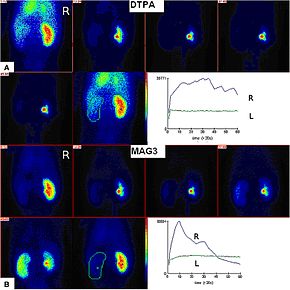Radioisotope renography
| Radioisotope renography | |
|---|---|
| Medical diagnostics | |

Renal imaging using 99mTc-DTPA and 99mTc-MAG3 with renographic curves
|
|
| ICD-9-CM | 92.03 |
| MeSH | D011866 |
| OPS-301 code | 3-706 |
Radioisotope renography is a form of medical imaging of the kidneys that uses radiolabelling. A renogram, which may also be known as a MAG3 scan, allows a nuclear medicine physician or a radiologist to visualize the kidneys and learn more about how they are functioning. MAG3 is an acronym for mercapto acetyl tri glycine, a compound that is chelated with a radioactive element – technetium-99m.
The two most common radiolabelled pharmaceutical agents used are Tc99m-MAG3 (MAG3 is also called mercaptoacetyltriglycine or mertiatide) and Tc99m-DTPA (diethylenetriaminepentacetate). Some other radiolabelled pharmaceuticals are EC (Ethylenedicysteine) and 131-iodine labelled OIH (ortho-iodohippurate).
After injection into the venous system, the compound is excreted by the kidneys and its progress through the renal system can be tracked with a gamma camera. A series of images are taken at regular intervals. Processing then involves drawing a region of interest (ROI) around both kidneys, and a computer program produces a graph of radioactivity inside the kidney with time, representing the quantity of tracer, from the number of counts measured inside in each image (representing a different time point).
If the kidney is not getting blood for example, it will not be viewed at all, even if it looks structurally normal in medical ultrasonography or magnetic resonance imaging. If the kidney is getting blood, but there is an obstruction inferior to the kidney in the bladder or ureters, the radioisotope will not pass beyond the level of the obstruction, whereas if there is a partial obstruction then there is a delayed transit time for the MAG3 to pass. More information can be gathered by calculating time activity curves; with normal kidney perfusion, peak activity should be observed after 3–5 minutes. The relative quantitative information gives the differential function between each kidney's filtration activity.
...
Wikipedia
